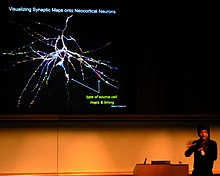Henry Markram

Henry Markram (born March 28, 1962 in the Kalahari , South Africa ) is an Israeli brain researcher of South African origin.
Life
Henry Markram spent his childhood on his parents' farm in the Kalahari Desert. When he was 13 he attended boarding school near Durban . He then studied medicine and neurophysiology in Cape Town . After completing his studies, he first conducted research at the Weizmann Institute in Israel. There he met his first wife and became an Israeli citizen. After completing his military service in Israel, he moved to the Max Planck Institute for Medical Research in Heidelberg , where he worked with Nobel Prize winner Bert Sakmann . In 2002, he received a call to the Massachusetts Institute of Technology , but he in favor of a better-paid offer of polytechnique Ecole fédérale de Lausanne rejected.
He is married to the German-Polish neuroscientist Kamila Markram; they have two children. Markram's son from his first marriage (Kai, * 1994) is autistic and prompted the couple to deal intensively with autism .
Act
He heads the research project Blue Brain , which is said to associate a blueprint of the brain with his name , at the École polytechnique fédérale de Lausanne (EPFL). Since an EU funding of 1 billion euros over 10 years as a European "lighthouse project", Markram's project to simulate and understand the inner mechanisms of the brain with neural networks on supercomputers is called the Human Brain Project . At the beginning of 2015, 800 scientists attacked the project and in particular Markram in an open letter. Blue Brain's claim to model the brain with computer technology in all its complexity is arrogant and unrealistic, and Markram's management style reflects this. His role as editor-in-chief of the Frontiers series, founded in 2007, is also criticized, which is classified by many scientists as highly dubious or as predatory publishing (e.g. by Jeffrey Beall ).
Autism research
The Markram couple have been researching a theory on autism for about 10 years , which is sometimes recognized as having an important role in autism research, while other scientists criticize its content and its dissemination via the controversial "Frontiers" series. Based on their neuroscientific research, the Markrams believe that autistic people have an "overly sensitive brain". I.e. the neural connections in autistic brains react faster and more intensely to sensory impulses, more impulses are processed than average, they are better stored, retained and remembered in detail. This hyper-functionality of perceiving, paying attention and remembering leads to different effects and individual neural patterns in every autistic child. As a result of these characteristics, the seemingly innate characteristics of the respective behavior that are considered typical of autism arise.
According to the Markrams, this hyper-functionality repeatedly leads to situations in autistic people in which they are emotionally overwhelmed, ie experience an 'overload'. They then tend to withdraw, avoid social contacts, including avoiding eye contact. Such emotionally overwhelming events are remembered as stressful. Each of these events becomes part of a series of incidents that can be processed as hostile. This has corresponding negative consequences in the assessment of autistic behavior by non-autistic people. The Markrams do not see social withdrawal as an innate deficit of the autistic personality, but rather as a consequence of negative events in the life of an autistic person.
literature
- Alexander Stirn: How do you build a brain, Mr. Markram? - Portrait: Henry Markram , in: PM Magazin 04/2014, pp. 34–37.
- Henry Markram , in: Internationales Biographisches Archiv 24/2013 from June 11, 2013, in the Munzinger archive ( beginning of article freely accessible)
- Lorenz Wagner: The boy who felt too much - How a world-famous brain researcher and his son change our image of autistic people forever. Europa Verlag 2018, ISBN 978-3-95890-229-9
Web links
- Literature by and about Henry Markram in the WorldCat bibliographic database
- Henry Markram on the website of the Blue Brain project
- Curriculum Vitae ( PDF file, 353 kB) - CV, May 2005 (English)
- Henry Markram - Profile with CV frontiers (English)
- Matthias Meili: A traveler through the cosmos of the human brain. Portrait in: Tages-Anzeiger from February 3, 2013
- Maia Szalavitz: In the name of the father, the son and the human brain. Portrait in the time of September 21, 2014
Individual evidence
- ↑ a b c d e f g h Alexander Stirn: How do you build a brain, Mr. Markram? , in: PM Magazin 04/2014, pp. 34–37, here p. 36
- ↑ See Kai's story: The Boy Whose Brain Could Unlock Autism. Free download
- ↑ Lorenz Wagner: The son code. When Henry Markram had an autistic child, he pounced on the question of what autism really is in: Süddeutsche Zeitung Magazin No. 11, March 17, 2017, pp. 40-43.
- ↑ EU research funding for the EPFL in Lausanne , swissinfo.ch, January 28, 2013
- ^ Scientific American Why the Human Brain Project Went Wrong
- ↑ https://forbetterscience.com/2017/09/18/frontiers-vanquishers-of-beall-publishers-of-bunk/
- ↑ Cf. Georg Theunissen : People in the Autism Spectrum. Stuttgart 2014, pp. 64–68. Theunissen names the following publication of the Markrams: Markram, K. & H. (2010): The Intense World Syndrome - a unifying theory if the neurobiology of autism, in: Frontiers in Human Neuroscience, Vol. 4,1-29 ( text online )
| personal data | |
|---|---|
| SURNAME | Markram, Henry |
| BRIEF DESCRIPTION | Israeli neuroscientist of South African origin |
| DATE OF BIRTH | March 28, 1962 |
| PLACE OF BIRTH | Kalahari , South Africa |
